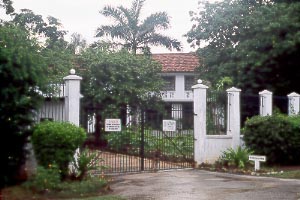| Church of St Peter and St Paul | |
|---|---|
| 51°42′03″N0°41′56″W / 51.7008°N 0.6988°W | |
| OS grid reference | SP 90015 01038 |
| Country | United Kingdom |
| Denomination | Church of England |
| Website | St Peter and St Paul |
| History | |
| Dedication | St Peter and St Paul |
| Architecture | |
| Heritage designation | Grade I listed |
| Administration | |
| Parish | Great Missenden with Ballinger and Little Hampden |
| Deanery | Wendover |
| Archdeaconry | Buckingham |
| Diocese | Oxford |
| Province | Canterbury |
Roald Dahl was born in Llandaff, Cardiff, Wales in September of 1916. His parents were Norwegian and had emigrated from Sarpsborg in the 1880s. The couple married in 1911 and Dahl was born five years later. His name was chosen in honour of the explorer Roald Amundsen. Find a Grave, database and images (accessed ), memorial page for Roald Dahl (13 Sep 1916–23 Nov 1990), Find a Grave Memorial no. 6940, citing St Peter and St Paul Churchyard, Great Missenden, Chiltern District, Buckinghamshire, England; Maintained by Find A Grave.
The Church of St Peter and St Paul is a Church of Englandparish church in Great Missenden, Buckinghamshire, England.
The church is Grade I listed.[1]
In celebration of Roald Dahl, St. Paul's Primary School children have come to school dressed as a character from their favourite Roald Dahl book. Roald Dahl’s Matilda The Musical. April 28 - June 23, 2019 Matilda’s dreadful parents hate her. Her headmistress is a life-sucking tyrant who locks children in.
Roald Dahl About The Author
The church dates mainly from the 14th century, heightened in the 15th century.[1] The tower's asymmetrical lower level results from the tower's extension to the south after the Reformation, with a wall nearly 14 feet thick, to support a new belfry to house five bells moved from the dissolved Missenden Abbey.[2] The church was restored, and the north-east aisle rebuilt, in 1899–1900[1] by John Oldrid Scott.[3]
The church is built of flintrubble, with sarsen stone footings and some dressings, some roughcast, other dressings in ashlar.[1]
The writer Roald Dahl, who lived in Gipsy House in Great Missenden, is buried in the churchyard.[4]
There are two Commonwealth War Graves Commission memorials in the churchyard, marking the burial place of two British soldiers. They commemorate Rifleman Jeffrey James Whitney of the Rifle Brigade, who died in September 1940, age 20, and Major Basil Arthur Parnwell of the Royal Fusiliers (City of London Regiment), who died in July 1947.[5]
See also[edit]

References[edit]
- ^ abcdHistoric England. 'Church of Saints Peter and Paul (1124812)'. National Heritage List for England.
- ^'St Peter and St Paul'. Retrieved 1 November 2019.
- ^'Great Missenden'. Church Crawler. Retrieved 1 November 2019.
- ^Roald Dahl at Find a Grave
- ^'Great Missenden (St Peter and Paul) Churchyard'. Commonwealth War Graves Commission. Retrieved 13 May 2020.

This is Roald Tweet on Rock Island.
Even the Mississippi River seems to know when it has crossed the Mason-Dixon line. The Upper Mississippi is a Yankee protestant-work-ethic river, always busy. The lower Mississippi below Cairo, Illinois, where the Ohio comes in, is a grander, more leisurely affair—a world of colonels and judges and mint juleps. No wonder that Currier and Ives chose to immortalize the steamboat race between the Natchez and the Robert E. Lee rather than between the small, plain packet boats north of St. Louis.

In that 1870 race, the Robert E. Lee won, and was awarded a pair of deer antlers to display atop the pilot house as the sign of victory, long a custom on the Lower Mississippi, where steamboat racing was an affair of gentlemen with time on their hands, a sport the same as deer hunting or horse racing. Races were announced several weeks in advance, and the boats gotten ready, the engines tuned, cargo cleared, and the crew trained. The race was a betting affair, a spectator sport, covered by the press.
On the Upper Mississippi, steamboat races were even more frequent, but they were all impromptu affairs engaged in by boats at work hauling cargo or passengers, who happened to meet on their way. Much as boys who are rivals for the same girl will do when they want to show off. 'Beat you to the corner,' the rival says. 'Beat you to Dubuque,' or 'See you in St. Paul,' the Captain of the challenging boat would cry—and the race would be on, putting in peril crew, passenger, and cargo. Boys, after all, will be boys.
And what did the winner get to wear on the roof of the pilot house or suspended between the smokestacks? No rack of antlers fresh from some gentleman's hunt graced the working packet boat. That was the South. Rather, it was a fit symbol for all those stereotypes we have of the North.
You may already have seen that victory symbol if you have looked closely at photographs of packet boats and remarked to yourself that the top of a pilot house was a very odd place to hang a push broom.
That broom tells you the winner has made a clean sweep.
Roald Dahlcollege St. Paul
Rock Island Lines with Roald Tweet is underwritten by Augustana College, Rock Island, Illinois.
